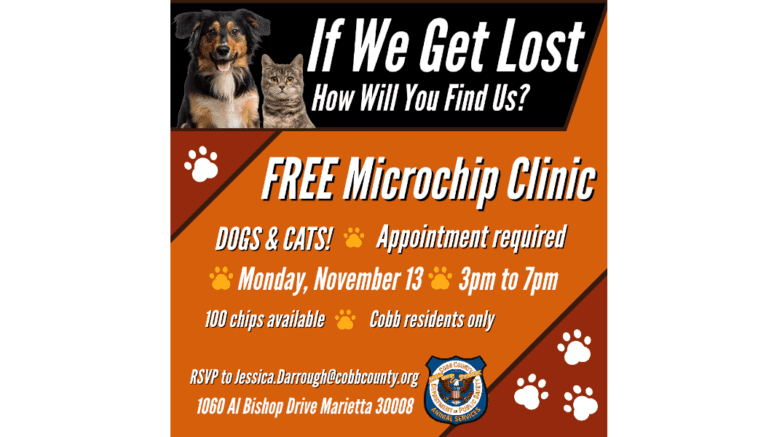by Inger Eberhart, Cobb County Department of Public Safety, Communications Specialist
For pet owners, the safety and well-being of their furry companions are of utmost importance. One powerful tool in safeguarding pets and reuniting them with their families is the microchip. The American Veterinary Medical Association (AVMA) provides a comprehensive FAQ on microchips, and we’ve summarized the key insights here.
Understanding the Microchip:
A microchip is a small electronic device, encased in a glass cylinder about the size of a grain of rice. Unlike traditional electronic devices, it doesn’t have a battery. Instead, it’s activated by a specialized scanner, which emits radio waves to activate the chip. Once activated, the chip transmits a unique identification number to the scanner, which is then displayed on a screen. This ingenious technology is often referred to as a transponder.
Implantation Process:
A common concern is whether implanting a microchip is painful and if it requires surgery or anesthesia. The answer is reassuring. The microchip is injected under the skin using a hypodermic needle, a procedure no more painful than a standard injection. While the needle is slightly larger, it does not require surgery or anesthesia. In fact, the microchip can be implanted during a routine veterinary office visit. For pets already under anesthesia for procedures like spaying or neutering, the microchip can be implanted simultaneously, adding minimal inconvenience.
Information Stored in Microchips:
Microchips used in pets contain only identification numbers. They are not tracking devices and cannot trace your pet’s location if they get lost. However, some microchip registration databases offer the option to store medical information for quick reference. Research laboratories and livestock or horse microchips may transmit body temperature data.
Privacy Concerns:
Pet owners often wonder about their privacy when it comes to microchipping. The information you provide to the manufacturer’s microchip registry is used solely for contacting you if your pet is found and its microchip scanned. You can usually choose to opt in or out of additional communications, like newsletters or advertisements. Your privacy is protected, and only the information you provide is accessible through the database. Random individuals cannot access your personal information.
Why Can’t I Implant a Microchip Myself?
While implanting a microchip may seem simple, it’s essential to have a veterinarian do it. Proper placement, depth, and location are critical for the chip’s effectiveness and your pet’s safety. Veterinarians understand the correct procedure, placement, and how to address any issues that may arise.
Monitoring After Implantation:
After microchipping, follow your vet’s instructions. If you notice unusual symptoms like drainage or swelling at the implant site, contact your veterinarian for guidance.
Maintaining Your Pet’s Microchip:
Three key steps are involved in maintaining your pet’s microchip:
- Register the microchip.
- Have your vet scan the microchip annually to ensure it’s working.
- Keep your registration data up-to-date, especially if your contact details change.
“Check the Chip Day,” observed on August 15 each year, is an excellent opportunity to review and update your pet’s microchip registration information.
In conclusion, microchipping is a safe, effective, and minimally invasive method for permanent pet identification. It enhances the safety of your beloved pets and increases the likelihood of reuniting with them if they become lost. It’s a small but crucial investment for responsible pet ownership, offering peace of mind and a higher probability of joyful reunions. Read more about microchipping and the microchip process at the American Veterinary Medical Association (https://www.avma.org/) & Microchipping FAQ (https://www.avma.org/resources-tools/pet-owners/petcare/microchips-reunite-pets-families/microchipping-faq#:~:text=A%3A%20It%20is%20injected%20under,a%20routine%20veterinary%20office%20visit.)





